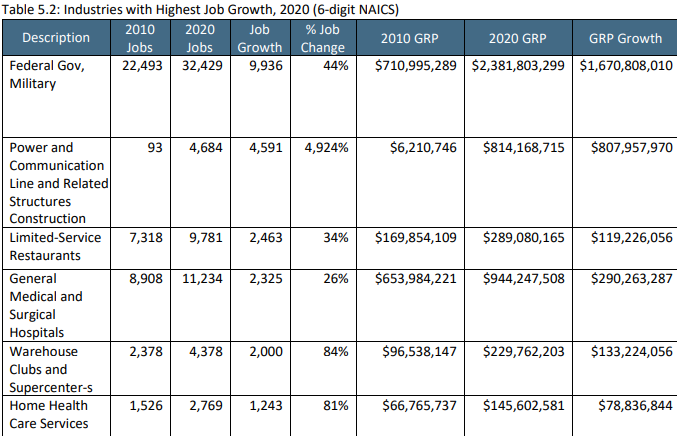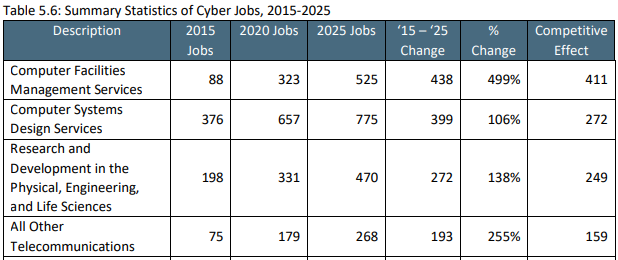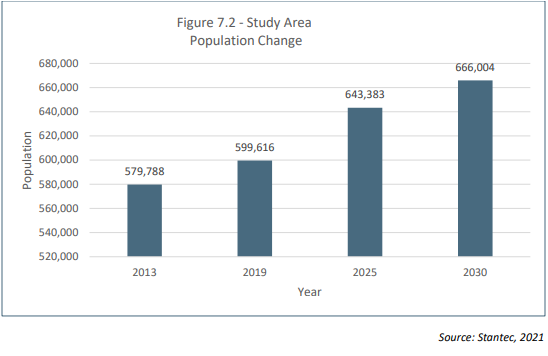The impact on economic and workforce development, education and health care connected to population growth associated with Fort Gordon were spotlighted in a virtual meeting on Dec. 15.
The regional growth management plan, coordinated by the CSRA Regional Commission, is trying to gauge the impact the population growth will have on the area. There are seven counties in the study, Augusta-Richmond, Columbia, Burke, Lincoln and McDuffie Counties in Georgia; Aiken and Edgefield Counties in South Carolina.
The commission is working with Canada-based Stantec, Inc.
Stantec’s Ray Greer explained, “The whole purpose behind deducted growth management plan is to really analyze the seven-county area, analyze what the impacts are associated with the growth both from a positive impact and from a negative impact. There’s significant amount of growth that has occurred since 2012 and that will continue to occur over the next several years.”
Looking at the economic factors, the draft report finds cyber growth has caused much of the change in the study area as it transitions to a predominately digital market. The technology growth will create new opportunities including in cybersecurity, health information technology and data centers along with related small businesses.
[adrotate banner=”13″]

Between 2010 and 2020, most industries logged a job increase. Construction and healthcare were among the strongest.
Leading the top 15 industries between 2010 to 2020, there were six that added more than 1,000 new jobs: Federal Government, Military (9,936); Power and Communication Line and Related Structures Construction (4,591); Limited-Service Restaurants (2,463); General Medical and Surgical Hospitals (2,325); Warehouse Clubs and Supercenters (2,000); Home Health Care Services (1,243).
From 2015 to 2020, most cyber jobs saw a net growth. That is expected to continue into 2025.

According to calculations on military job growth, it is projected that 894 jobs will be added to the installation between 2021 and 2024. That is expected to create up to 1,560 additional jobs. It is anticipated that earnings for all new jobs would create an additional $133 million in regional earnings.
Population growth and corresponding increased consumer spending on good and services increases the total size of the economy. It also means employers can find employees locally rather than spending money to recruit and relocate people from outside the study area.

The study said the region needs to connect workers with good quality jobs while providing employers with skilled, qualified employees. The draft report recommends the Augusta area consider four strategies:
1. Create a regional association for defense contractors
2. Identify expansion opportunities for existing businesses
3. Develop or align a business attraction strategy focusing on target industries
4. Leverage existing initiatives and investments in cyber at Fort Gordon
[adrotate banner=”51″]
The study singled out The CSRA Alliance for Fort Gordon as a success in supporting both the defense and private sectors in technology. Workforce development activities include cyber training and job placement for veterans and spouses at no cost.
The study recommended that the area may want to explore a partnership with the National Military Family Association. It also recommends the Socratic Arts’ Cyber Academy. It’s a program funded by the Department of Defense to provide cybersecurity scholarships to military spouses. That can use the growth of Fort Gordon to create higher paying jobs for military spouses. It would also grow the civilian cyber security industry.
Turning its attention to education, the study concluded the population growth connected to the Cyber Command at Fort Gordon will expand the need for education services in the seven-county region.
The study found the majority of students from active-duty service members attend school in Richmond and Columbia Counties. Middle and high schools include a cyber component in the curriculum. It focuses on IT and computer sciences and is designed to keep future minds local to be part of the cyber district.
The study looked at existing schools; 17 in Columbia County with current enrollment of 27,818 students and 60 in Richmond County with 29,093. The projected population growth at Fort Gordon is expected to have a corresponding enrollment increase in schools.

The study said Richmond County identified the need for two new schools based on the latest right-sizing meeting. It also said Columbia County is planning at least two new elementary schools by 2025.
“One of the things that we did see — which is a good thing we’ve seen it in other places of the country — is the school boards working with planning departments,” said Greer. “It does provide the ability to obtain land that way for new schools inside areas that are under high growth.”
Among the recommendations is that schools expand cyber curriculum to all schools. Potential benefits are twofold: It can provide a head start for students who want to pursue a career in the field, and it also trains and grows the local workforce for careers in cyber fields. It is also recommended that school districts invest in technology upgrades.
Chapter Seven of the planned nine chapters focuses on health care. It used 2013 as a recovery date following the 2008-2009 recession, 2019 which is the most recent available data and 2030 is five years beyond when expansion is complete.
Between 2019 and 2025, population growth is projected to be 7.3% after growing by just 3.4% from 2013 to 2019. Growth is expected to be 3.5% between 2025 and 2030.

[adrotate banner=”19″]
The study anticipates 15% of the 2019 through 2025 growth will be connected to expansion at Fort Gordon. Half would be military personnel, the other half would be military families and support personnel. The new population is expected to primarily be people in their 20s and 30s, a younger population that tend to require less healthcare than senior citizens. The study also noted that military personnel have health coverage through TRICARE.
Examining healthy behaviors and environment, the study listed a number of issues with a high priority that need improvement. This includes substance abuse, mental health concerns such as depression and anxiety, tobacco use, dental care and food deserts.
The study breaks down the number of primary care providers, dentists and mental health providers. It found 439 primary care physician providers in 2019. Based on the anticipated growth, the study area will need 76 new providers by 2030 to meet the current national average.
In 2019, the study said there were 540 dentists, which is above the national rate per 10,000 people and would still exceed the national rate in 2030 with an increase in providers. With 180 mental health providers in 2019, the study area falls short of the national rate by 134 providers. Based on anticipated population growth, the area will need 158 new providers by 2030.
The study also advises the area needs an additional 1,638 general hospital employees, the equivalent of an average sized hospital. The study recommended construction of one additional hospital in the study area. Although not mentioned in the study, the 100-bed hospital planned for Columbia County was mentioned during the virtual meeting as a way to close the gap.
The reports are available for review and comment on the project website.
Recordings of the virtual public meetings are posted to the project site.
Comments can also be submitted through the project public input form or by email to cpappis@csrarc.ga.gov
A date was not announced for when the final three chapters, which will include housing and child care services, will be posted to the website and another virtual meeting will be scheduled.
Dana Lynn McIntyre is a Staff Reporter with The Augusta Press. You can reach her at dana@theaugustapress.com













